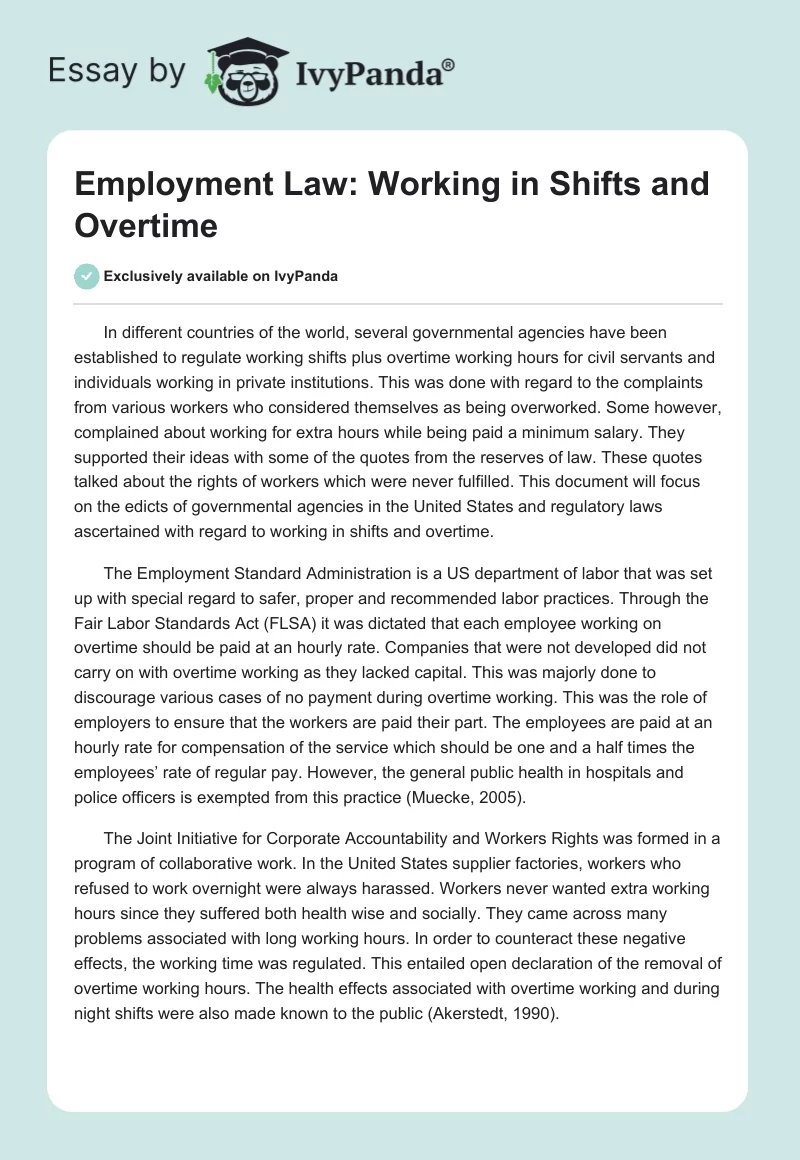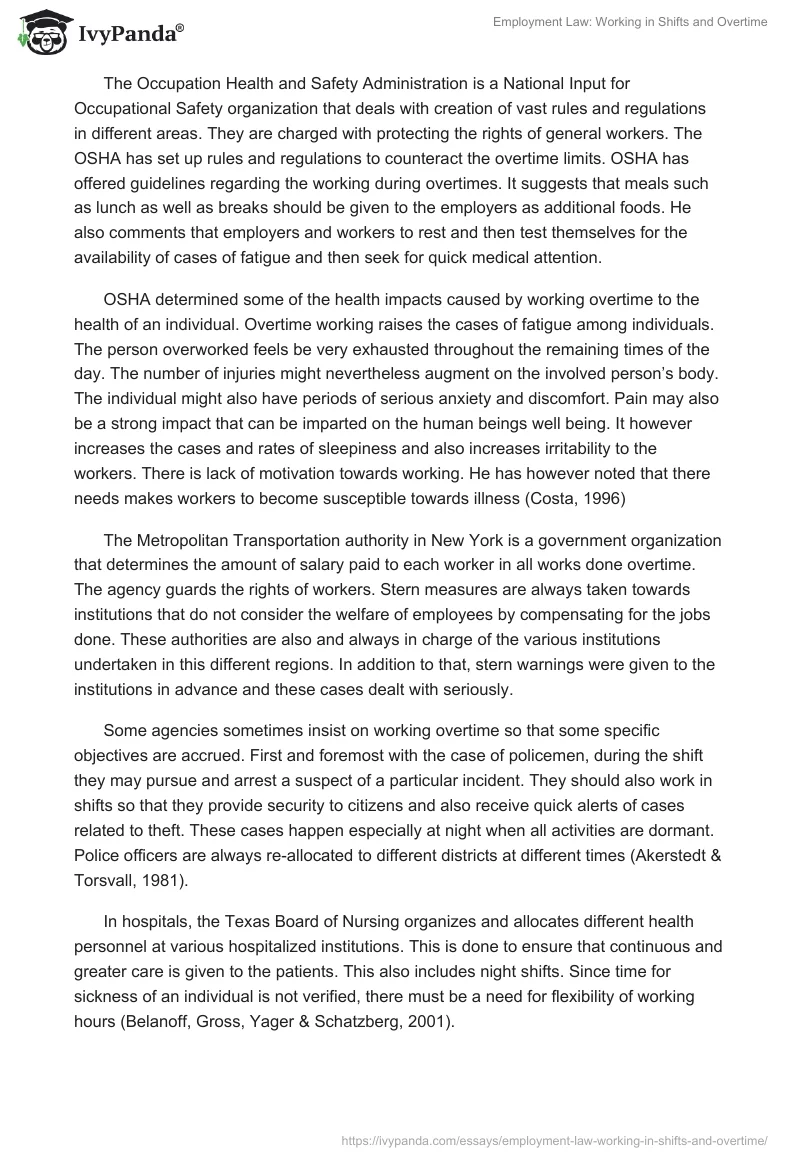In different countries of the world, several governmental agencies have been established to regulate working shifts plus overtime working hours for civil servants and individuals working in private institutions. This was done with regard to the complaints from various workers who considered themselves as being overworked. Some however, complained about working for extra hours while being paid a minimum salary. They supported their ideas with some of the quotes from the reserves of law. These quotes talked about the rights of workers which were never fulfilled. This document will focus on the edicts of governmental agencies in the United States and regulatory laws ascertained with regard to working in shifts and overtime.
The Employment Standard Administration is a US department of labor that was set up with special regard to safer, proper and recommended labor practices. Through the Fair Labor Standards Act (FLSA) it was dictated that each employee working on overtime should be paid at an hourly rate. Companies that were not developed did not carry on with overtime working as they lacked capital. This was majorly done to discourage various cases of no payment during overtime working. This was the role of employers to ensure that the workers are paid their part. The employees are paid at an hourly rate for compensation of the service which should be one and a half times the employees’ rate of regular pay. However, the general public health in hospitals and police officers is exempted from this practice (Muecke, 2005).
The Joint Initiative for Corporate Accountability and Workers Rights was formed in a program of collaborative work. In the United States supplier factories, workers who refused to work overnight were always harassed. Workers never wanted extra working hours since they suffered both health wise and socially. They came across many problems associated with long working hours. In order to counteract these negative effects, the working time was regulated. This entailed open declaration of the removal of overtime working hours. The health effects associated with overtime working and during night shifts were also made known to the public (Akerstedt, 1990).
The Occupation Health and Safety Administration is a National Input for Occupational Safety organization that deals with creation of vast rules and regulations in different areas. They are charged with protecting the rights of general workers. The OSHA has set up rules and regulations to counteract the overtime limits. OSHA has offered guidelines regarding the working during overtimes. It suggests that meals such as lunch as well as breaks should be given to the employers as additional foods. He also comments that employers and workers to rest and then test themselves for the availability of cases of fatigue and then seek for quick medical attention.
OSHA determined some of the health impacts caused by working overtime to the health of an individual. Overtime working raises the cases of fatigue among individuals. The person overworked feels be very exhausted throughout the remaining times of the day. The number of injuries might nevertheless augment on the involved person’s body. The individual might also have periods of serious anxiety and discomfort. Pain may also be a strong impact that can be imparted on the human beings well being. It however increases the cases and rates of sleepiness and also increases irritability to the workers. There is lack of motivation towards working. He has however noted that there needs makes workers to become susceptible towards illness (Costa, 1996)
The Metropolitan Transportation authority in New York is a government organization that determines the amount of salary paid to each worker in all works done overtime. The agency guards the rights of workers. Stern measures are always taken towards institutions that do not consider the welfare of employees by compensating for the jobs done. These authorities are also and always in charge of the various institutions undertaken in this different regions. In addition to that, stern warnings were given to the institutions in advance and these cases dealt with seriously.
Some agencies sometimes insist on working overtime so that some specific objectives are accrued. First and foremost with the case of policemen, during the shift they may pursue and arrest a suspect of a particular incident. They should also work in shifts so that they provide security to citizens and also receive quick alerts of cases related to theft. These cases happen especially at night when all activities are dormant. Police officers are always re-allocated to different districts at different times (Akerstedt & Torsvall, 1981).
In hospitals, the Texas Board of Nursing organizes and allocates different health personnel at various hospitalized institutions. This is done to ensure that continuous and greater care is given to the patients. This also includes night shifts. Since time for sickness of an individual is not verified, there must be a need for flexibility of working hours (Belanoff, Gross, Yager & Schatzberg, 2001).
In a business scenario, whenever the demand for the manufactured merchandise is high, a double effort of labor is needed to meet the needs of the consumers. Those workers accused of absenteeism might end up losing the job. If employees work hard with togetherness, then a large profit is realized. Therefore, there is need for flexibility in working hours for the great competitive companies (Folkard & Tucker, 2003).
The Medicare Payment Advisory Commission (MEDIPAC) discourages working during irregular hours as they attribute this to ill-health among individuals in the society. A particular pattern of work has been attributed to cause illness to persons. Health illnesses have been pointed out to be highly accountable from the long working hours without rest. Specific individuals acquire difficulties related to health through smoking and generally the abuse of drugs. Most of the people apply drugs to boost their alertness throughout the night (Folkard & Tucker, 2003).
The Tennessee Valley Authority (TVA) has set up rules to prevent the managers from forcing their members of staff to work excessively for long hours. They openly eliminated overtime working. These laws play a role in safeguarding the humanitarian part of their well being. They also protect persons from getting ill and thus their productive potentials are preserved. Through this, their life when employed is as prolonged thus long services offered to the nations. They consequently promote the economic growth of the nations (Costa, 1996).
In South America, individual workers who work overtime are charged. A certain amount of capital is incriminated on the employer as well as the employee. This capital is termed as tax. The tax charged depends on the total time spend especially per year, on overtime.
Reference List
Akerstedt, T. (1990). Psychological and psychophysiological effects of shift work. Scandinavian Journal of Work, Environment and Health, 16(1), 67-73.
Akerstedt, T., and Torsvall L., (1981). Shift work: Shift-dependent well-being and individual differences. Ergonomics, 24(4), 265-273
Belanoff, J. K., Gross, K., Yager, A., and Schatzberg, A. F. (2001) Corticosteroids and cognition. Journal of psychiatric research, 35, 125-137.
Costa, G. (1996). The impact of shift and night work on health. Applied Ergonomics, 27(1), 9-16.
Folkard, S., and Tucker, P. (2003). Shift work, safety and productivity. Occupational medicine, 53(2), 95-101.
Muecke, S. (2005). Effects of rotating night shifts: literature review. Journal of Advanced Nursing. 50(4), 433-439.


